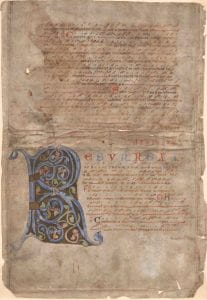A leaf from medieval gradual

This beautiful piece of manuscript is a leaf from a 11th or 12th century gradual, mostly likely originating in Austria or Southern Germany. It features brown and red script on vellum, and several decorative and colourful illuminations. While it might seem strange for a collection to contain a single page from a manuscript, it was relatively common in the world of rare book selling in the early 20th to separate manuscripts into pages to make them more sellable to a larger audience. While on one hand, it seems reprehensible to have broken up manuscripts which had survived centuries for the sake of profit, it did achieve the goal of making these medieval manuscripts, if only a sliver of them, more accessible to a larger number of libraries and collectors around the world. The leaf also shows evidence of folding around the edges, which suggests is also could have been used as a binding stiffener in another later book. Bits and pieces of medieval manuscripts have a remarkable propensity to show up hidden within all sorts of more modern works before they are found by an intrepid librarian and brought again to the light.
A gradual is a liturgical book of the Roman Catholic Church containing the antiphons, chants, and psalms essential to the celebration of Mass. The last official edition of the gradual was distributed in 1974, however despite the centuries spanning between this 20th century publication and the leaf, the devotional words written within are recognisably similar. The large ‘R’ on the lower left side of the leaf, illuminated with blue along with pink and green floral detailing, begins the antiphon ‘Resurrexi et adhuc’. An antiphon is a short verse from the Holy Scriptures which is sung or recited before and after a psalm. The first few lines of text following the decorative ‘R’ read:
Resurrexi et adhuc tecum sum, alleluia:
I rose and thus I am with you, alleluia
posuisti super me manum tuam, alleluia:.
I placed your hand above me, alleluia
mirabilis facta est scientia tua alleluia
Your miraculous knowledge is brought forth, alleluia
After this third alleluia, the leaf shows a red symbol which appears to be a cross with a swirl coming from the top right segment. This symbol marks the conclusion of the antiphon and beginning of the psalm, which continues:
Domine probasti me et cognovisti me:
Master, you calmed me and you understood me:
tu cognovisti sessionem meam
You learnt from my life
et resurrectionem meam
and my resurrection
(Gradual) Haec dies quam fecit Dominus:
As The Lord created these days:
exsultemus et laetemur in ea
We exalt and are gladdened in Him
(Verse) Confitemini Domino quoniam bonus
They confess in the Lord because He is good
quoniam in saeculum misericordia eius
as His compassion is in all people
The lines of gradual and verse, are marked by a red “Gr” and “v”, respectively. The term ‘gradual’ applies both to the book in its entirety, and a specific type of hymn within it.
Liturgical songs and their performance play a central role in the Catholic tradition, with the term ‘liturgy’ coming from the Greek word λειτουργίας, meaning ‘public work’. Singing, either by the congregation or a church choir, continues the work of God, by sharing His word and praising His name. As can be seen with this piece of medieval song, liturgical music is composed of a complex blend of alleluias, antiphons, quotes from psalms, and repeated phrases of devotion. Along with setting out the lyrics and music for a church singer to follow, a gradual also provides information as to when is appropriate to perform particular songs. For example, when listed in the 1974 Gradual, this ‘Resurrexi et adhuc’ antiphon is included in the chapter ‘Ad Liturgiam Baptismalem’, or, songs for baptisms.
Another notable aspect of this leaf aside from the lyrics is the way in which the music itself is notated. A neume is a form of musical notation from before the invention of the five-line stave system. Neumes are a series of dots and squiggles, adapted from the accentual signs originally used in Latin script. There are various scripts with which neumes were written. Those of this leaf, showing small horizontal squiggles and larger looping shapes similar to ticks and capital ‘U’ and ‘V’ letters, appears to be closest to the Messine script developed in the north-east of France in the 12th century. Another variation in neumes is whether they are diastematic or adiastematic, referring to what extent they provide information on relative pitch. These neumes are adiastematic, meaning that they record musical movement and note length (the long red lines in the centre of some words seem to suggest they should be held for a longer note) but not pitch. The exact contours of the tune and how high or low each note was to be sung was up to the interpretation of the singer.
With the huge range of liturgical music and notation such as adiastematic neumes allowing dissimilarities in how they were performed, possibly varied by church or even individual, medieval church-goers would have been privy to a dazzling assortment of music with which to praise their God. While the medieval period can at times feel so removed from our modern world, the joy and community that music, liturgical and otherwise, brings to our society is one in which we have always partaken. Looking at pieces of rare and historical music like this leaf from a gradual reminds us of how humans have always celebrated the power of song and, with reverence, lifted our voices to the sky.
Adelaide Greig
Print Room Intern
Notes and further reading
Pryer, Anthony. The Oxford Companion to Music. edited by Alison Latham, (Oxford: Oxford University Press), 2011.
Catholic Church, Graduale Romanum, (Tornaci: J. Thomas), 1973.
Mauk, Ben, Scattered leaves in the The New Yourker, 2014.
Leave a Reply